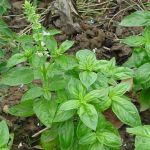| Common Name: |
Kemangi |
| Other Names: |
Lemon Basil |
| Botanical Name: |
Ocimum x. citriodorum |
| Genus: |
Ocimum |
| Family: |
Lamiaceae |
| Native Location: |
SE Asia to NE Africa |
| Cultivation: |
Rich, light, well-drained to dry soil in sun, pH5-8. Pinch out growing tips to encourage bushiness and delay flowering. Ocimum x. citriodorum dislikes transplanting so is best sown in situ. Slugs, aphids, whitefly, spider mites, and Botrytis may attack plants. Basil is often used in companion planting because it is said to repel aphids, asparagus beetles, mites, and tomato hornworms, and to slow the growth of milkweed bugs. |
| Propagation: |
By seed sown in spring at 13°C (55°F); by softwood cuttings in spring (perennials and shrubs). |
| Harvest: |
Whole plants (O. americanum, O. basilicum, O. gratissimum, O. tenuiflorum) are cut just before flowering begins and dried or distilled for oil. Leaves are picked during the growing season and used fresh or juiced, or dried for infusions and decoctions. Ocimum tenuiflorum is prepared as powder adn medicated ghee. Seeds (O. americanum, O. basilicum, O. tenuiflorum) are collected when ripe and dried for decoctions. Roots are harvested and dried for decoctions. |
| Height: |
30-45cm (12-18in) |
| Width: |
25cm (10in) |
| Variations: |
Lesbos
syn. Aussie Sweetie, Greek Column
Has a narrowly upright, columnar habit, and small leaves with a typical sweet basil flavor; seldom blooms.
Height: 90cm (36in) |
Mrs. Burns' Lemon
Is robust, with large, lemon-scented leaves, and white to pink flowers. An old New Mexican cultivar.
Height: 1m (3ft) |
|
| Hardiness: |
Min. 10°C (50°F) |
| Parts Used: |
Leaves, seeds. |
| Properties: |
An aromatic herb with a strong lemon-basil flavor. |
| Culinary Uses: |
leaves are used with fish and chicken, and in herb vinegars. Seeds are soaked in water to make a tonic drink. |
| Bibliography: |
Encyclopedia of Herbs by Deni Brown Copyright © 1995, 2001 Dorling Kindersley Limited. pp 290-292 |
